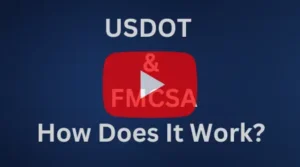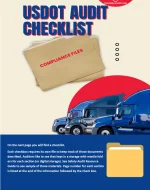If you’re a Texas-based motor carrier with an inactive MC number, you’re facing a serious compliance issue that can halt your operations and cost you valuable business. Fortunately, there is a clear path forward. In this guide, we’ll explain how to reactivate your MC number in Texas, while also highlighting why working with compliance experts can help you avoid common mistakes and unnecessary delays.

Why Reactivating Your MC Number in Texas Is More Complex
Texas stands out from other states due to its dual authority system. Carriers based in the Lone Star State often require two separate forms of operating authority:
- Interstate authority, governed by the Federal Motor Carrier Safety Administration (FMCSA) via your MC number.
- Intrastate authority, regulated by the Texas Department of Motor Vehicles (TxDMV) through a TxDMV certificate.
Because these two authorities operate under different agencies, maintaining or reactivating both at the same time requires careful coordination. Reactivating your MC number in Texas often involves:
- Resolving federal compliance issues with FMCSA
- Maintaining valid state filings with TxDMV
- Synchronizing insurance filings across federal and state systems
Skipping any of these steps or completing them in the wrong order can trigger further delays or even denial of reactivation.
Why MC Numbers Become Inactive in Texas
There are several common reasons that an MC number may become inactive, especially for Texas-based carriers:
- Insurance lapses: A missed or expired BMC-91/BMC-91X filing with FMCSA triggers immediate suspension of your MC number.
- State-specific filings: Texas requires Form E (and sometimes Form H & I) for TxDMV compliance. Gaps in state filings can complicate federal reactivation.
- Missed biennial MCS-150 updates: Forgetting to update your DOT number can result in FMCSA marking your number inactive.
- Outdated contact info: If FMCSA cannot reach you, you risk deactivation.
- Safety violations or enforcement actions: Carriers flagged as unsafe may have their authority revoked pending resolution.
Step-by-Step Overview: How to Reactivate Your MC Number in Texas
Here’s a simplified outline of the process. While we’re offering an overview, keep in mind that our team can handle all of these filings and communications for you—saving you time and preventing costly mistakes.
1. Review Your USDOT & MC Status
- Use the FMCSA SAFER System to check your DOT status.
- Check your MC status via the Licensing & Insurance portal.
- Confirm your TxDMV certificate status through the Motor Carrier Credentialing System (MCCS).
2. Update the MCS-150 (if needed)
If your USDOT number is inactive, you’ll likely need to file a new MCS-150 form to update your operational status and company information.
3. Coordinate Insurance Filings
This is one of the most common stumbling blocks:
- Federal filings: Ensure your insurer files BMC-91 or BMC-91X directly with FMCSA.
- Texas filings: Make sure Form E (and Forms H & I, if applicable) are submitted to TxDMV.
- Timing is critical—filings must be submitted and appear in both systems before reactivation is possible.
4. Verify BOC-3 Filing
All interstate carriers must have a valid BOC-3 on file. Use a trusted process agent to ensure you’re covered in all required states.
5. Submit the Reinstatement Request
Submitting the formal request to reinstate your MC number sounds simple—but even small mistakes can cause delays or denials.
Need Help Obtaining Your Permits?
Get Your Trucking Authority Today!
We Can Help Setup Your USDOT & MC Number.
Speak With Our Experienced Permit Professionals That Can Help You Every Step Of The Way.
Call Us Today! Live Agents Are Standing By.
Common Pitfalls:
- Submitting too early before FMCSA has processed insurance or BOC-3 filings
- Failing to address prior enforcement actions or compliance flags
Instead of going it alone, let our experienced team take care of this step for you. We know what to look for, what to fix, and how to file everything correctly the first time.
Special Texas Compliance Considerations
Texas adds an extra layer of complexity to the reactivation process:
- Your TxDMV certificate must stay active during MC number reactivation to avoid dual compliance issues.
- State-specific insurance rules require real-time monitoring of your filings. If your Form E lapses, it could trigger enforcement—even if your federal filings are in order.
- Drug testing programs must remain compliant for intrastate carriers.
Mistakes Texas Carriers Should Avoid
Here are the most common errors we see:
- Focusing only on FMCSA and forgetting TxDMV requirements
- Insurance miscommunication: Not all agents understand both federal and state filing procedures
- Submitting your reinstatement request too early—before all supporting documents are processed
- Assuming you’re cleared to operate once the request is submitted (you’re not until FMCSA shows “Authorized”)
Why You Should Let Us Handle It
The reactivation process isn’t just about submitting a form—it’s about coordinating multiple documents, systems, and agencies. Our compliance experts handle:
- Insurance filing coordination (FMCSA + TxDMV)
- BOC-3 submission and tracking
- MCS-150 updates and DOT status recovery
- Reinstatement form preparation and filing
- Ongoing compliance reminders to prevent future lapses
You focus on your business—we’ll handle the paperwork.
Ready to Get Back on the Road?
Reactivating your MC number in Texas doesn’t have to be overwhelming. With the right support, you can avoid common errors, meet every requirement, and get back to running your business smoothly.
📞 Contact us today to schedule your reactivation consultation. We’ll assess your situation, guide you through the steps, and manage the entire process on your behalf.
Frequently Asked Questions (FAQs)
1. Can I operate with my TxDMV certificate if my MC number is inactive?
Only for intrastate operations. You cannot cross state lines until your MC number is reactivated.
2. How long does it take to reactivate an MC number in Texas?
It varies, but with all requirements met, typically 1–3 weeks. Delays happen when paperwork is incomplete or misfiled.
3. What causes the most reactivation delays?
Insurance filing issues and premature submission of the reinstatement request.
4. Do I need to submit my BOC-3 again?
Yes, it’s best to refile it even if you previously submitted one—especially if your MC number has been inactive for a while.
5. Can I do this myself?
You can, but most carriers find that working with a compliance expert prevents delays and denials.
6. Is there a fee for reactivation?
Yes, FMCSA charges a non-refundable fee. We can handle the payment and submission as part of our service.
7. What happens if I miss my MCS-150 filing again?
Your DOT number may become inactive again, which will shut down your operating authority.
8. Do I need to notify TxDMV after MC reactivation?
Not directly, but maintaining your TxDMV filings ensures you’re compliant at both levels.
9. Can I use the same insurance policy for FMCSA and TxDMV?
Yes, but it must be filed correctly with both agencies. We help your provider handle both filings.
10. What if FMCSA or TxDMV asks for more documents?
We’ll respond on your behalf and make sure everything they need is submitted promptly.







